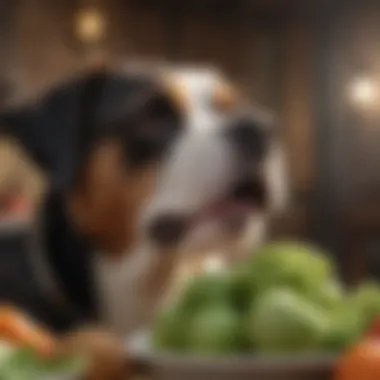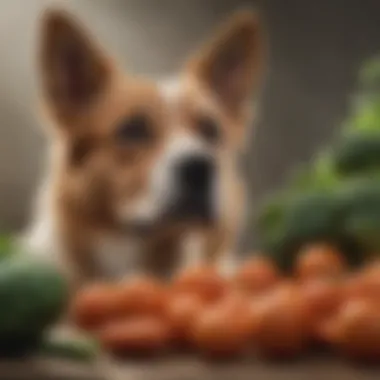Hazardous Vegetables for Dogs: What to Avoid


Intro
When it comes to our beloved furry companions, diet plays a crucial role in their overall health and happiness. While many vegetables can be a healthy addition to a dog's diet, some should never see the light of day on their dinner plate. This guide aims to shed light on the vegetables that pose risks to dogs, helping pet owners make informed dietary choices. Understanding what can harm dogs is vital not only for their daily meals but also for their long-term health.
Animal Overview
Understanding the canine physiology helps in discerning the types of food that can be harmful to dogs. Their bodies process certain substances differently than humans do, which is why some veggies can be toxic.
- Common Name and Scientific Classification: Dogs, Canis lupus familiaris, have co-evolved with humans and share certain digestive characteristics but also differ markedly from us.
- Physical Characteristics: Dogs come in assorted shapes and sizes, from tiny Chihuahuas to massive Great Danes. Their digestive system is built for a protein-rich diet that has implications for what vegetables they can handle safely.
- Habitat and Distribution: While dogs are primarily household pets now, their ancestors roamed various habitats. Their evolutionary history influences their dietary needs even today.
The Importance of Knowing
Pet owners must be aware of the vegetables that could pose health risks. Some common examples include:
- Onions and Garlic: Both belong to the Allium family and can damage red blood cells.
- Mushrooms: Certain wild mushrooms are toxic and can lead to liver damage remarkably quickly.
- Avocado: Contains a substance called persin which can lead to vomiting and diarrhea in dogs.
Recognizing Symptoms
It's often said that a picture is worth a thousand words, but when it comes to dog health, knowing symptoms can be life-saving. Common reactions to these toxic vegetables might include:
- Vomiting and diarrhea
- Lethargy
- Abdominal pain
- Increased heart rate
If your dog exhibits these symptoms after consumption of known toxic veggies, a quick trip to the vet is crucial.
Safe Alternatives
Being aware of what not to feed is just as important as knowing what alternatives exist.
Consider healthier options like:
- Carrots: Low in calories and great for dental health
- Green beans: Good source of vitamins and low in fat
- Sweet potatoes: Packed with nutrients and safe for dogs
Informed pet owners can better ensure their furry friends live a long, healthy life by understanding which foods to avoid.
Ending
In summary, knowledge is power when it comes to our dogs’ diets. Focusing on the vegetables to avoid is just one piece of the puzzle. An understanding of safe and nutritious options allows for better health, ensuring our pets lead vibrant, happy lives. Making informed decisions as pet owners means fewer worries and a lot of love in the long run.
Prolusion to Canine Nutrition
Understanding canine nutrition is crucial for any dog owner who wants their furry companions to live healthy and happy lives. Just like humans, dogs require a balanced diet that offers the right mix of nutrients to thrive. This article explores what goes into their meals and why some foods can be dangerous for their health.
A well-structured diet entails more than just filling a bowl with food. It is about providing the right proportions of proteins, carbohydrates, fats, vitamins, and minerals. For instance, while dogs are generally considered omnivores, their digestive systems are uniquely adapted to process certain foods differently from humans. Thus, some human food that seems harmless can actually present significant health risks.
Importance of a Balanced Diet
A balanced diet offers numerous benefits, such as promoting a strong immune system, supporting healthy growth, and maintaining optimal energy levels. When dogs consume all necessary essential nutrients, they can better resist illnesses and infections. Additionally, maintaining a healthy weight through proper diet can reduce the risk of developing chronic conditions such as diabetes or joint issues later in life.
Here are several key reasons why a balanced diet is vital for dogs:
- Nutrient Absorption: Just as engines require fuel, dogs need the right nutrients for their bodies to function efficiently.
- Behavioral Stability: A dog’s mood and energy levels can be affected by what they eat. Low-quality or unbalanced diets might lead to behavioral problems.
- Longevity: Feeding a quality diet can enhance a dog's lifespan. Healthy pets tend to live longer and experience fewer health issues as they age.
Common Misconceptions About Dogs and Vegetables
Many dog owners believe that all vegetables are safe and healthy for their pets. While some vegetables can provide essential vitamins and minerals, others can be toxic or harmful. This misconception can arise from not understanding the differences between human and canine digestion and nutritional needs. For instance, a snack of carrot sticks is vastly different from letting a dog nibble on onions or garlic.
Dogs have digestive systems adapted for consuming meat, and not every vegetable serves them well. Knowing which vegetables are harmful is crucial. Here are a few common stereotypes to clarify:
- "All veggies are good for dogs": Not true. While some are beneficial, others can cause serious health problems.
- "Cooking eliminates the risk": Some harmful substances remain intact even after cooking. For example, the toxins in certain mushrooms will not vanish with heat.
- "If it's safe for humans, it's safe for dogs": This is misleading. Many common foods safe for humans can cause toxic reactions in dogs.
Understanding can influence the health and overall well-being of dogs. Instead of sharing your plate without thought, it is essential to conduct some research or seek vet advice before introducing any new foods. This approach not only promotes a happier pet but also avoids potential health crises.
Understanding Canine Digestive System
Understanding the canine digestive system plays a crucial role in shaping appropriate dietary practices for dogs. This part of the article dives into how dogs digest food and how this process impacts their health, especially when it comes to consuming vegetables. Recognizing these elements can help owners make better choices and avoid potential threats associated with certain foods.
Differences Between Canine and Human Digestion
When we munch on a salad, our bodies easily absorb the nutrients packed in those veggies. But dogs? Well, their digestive systems are a whole different ballgame. For starters, dogs are classified as carnivores, although they have adapted to an omnivorous diet over time. Their intestinal tract is relatively shorter than ours, primarily 因為 they process meat more efficiently. This means they may have a tougher time breaking down fibrous vegetables.
Also, the enzyme composition in a dog's saliva differs from that of humans. While we have enzymes that break down starches, dogs produce more proteases, which help in digesting proteins. This biological difference means that certain vegetables can become more of a challenge for dogs to digest, sometimes leading to gastrointestinal issues.
"Unlike humans, dogs have a shorter intestinal length. This means faster digestion, but it can affect their ability to extract nutrients from certain plant-based foods."


How Dogs Process Various Foods
Dogs process food in stages, starting with mechanical breakdown in the mouth and continuing through a rapid journey through the stomach and intestines. However, the manner in which they handle foods—especially vegetables—requires a keen understanding from pet owners.
- Mastication: Dogs may not chew their food as thoroughly as needed for efficient digestion. With larger chunks of vegetables, this can lead to complications.
- Stomach Acid: Dogs have stronger stomach acids than humans do. While this trait helps in breaking down proteins, it doesn't aid as much in breaking down fibrous plant material. This results in undigested or poorly digested veggies.
- Gut Microbiome: Dogs' intestines harbor a unique blend of bacteria that assists in digestion, but they are tailored more towards meat. Introducing certain vegetables can disrupt this balance, leading to discomfort and food intolerances in some dogs.
The nutritional value of vegetables varies, but if a dog can't digest them properly, they might not gain any benefits. Pet owners must be wary; a food's supposed health benefits can't be reaped if digestion fails.
In summary, knowing how dogs digest food is key to preventing health complications from consuming unsafe vegetables. This understanding helps bridge the gap between human dietary habits and what truly nourishes canine wellness.
Vegetables That Are Toxic to Dogs
When it comes to feeding our canine companions, understanding what they shouldn't eat is just as crucial as knowing what they can. The topic of vegetables that are toxic to dogs sheds light on common offenders that might lurk in our kitchens or gardens. Knowing these hazards helps you avoid potentially life-threatening situations and enables you to make informed choices about your dog’s diet.
"An ounce of prevention is worth a pound of cure."
Onions and Garlic
Onions and garlic may add flavor to our meals, but they can be a poison for dogs. These two vegetables contain compounds called thiosulfates which are problematic for dogs.
Mechanism of Toxicity
The mechanism of toxicity primarily revolves around oxidative damage to red blood cells. When a dog consumes onions or garlic, thiosulfates can lead to hemolytic anemia. This type of anemia means that the dog's body is destroying its own red blood cells, leaving them weak and lethargic. Importantly, even small amounts of these vegetables can be harmful, making it a crucial topic to discuss for dog owners.
Symptoms of Consumption
Symptoms from eating onions or garlic may not appear immediately. Dogs might show signs like vomiting, diarrhea, weakness, or an unusual rapid breathing pattern days after consumption. This characteristic delayed reaction often catches pet owners off guard, as they might not connect the dots regarding when their dog actually consumed the harmful food.
Avocado
Though people often tout avocados as a superfood for humans, the same can't be said for dogs.
Persin Toxicity
Inside the creamy fruit, there's a compound known as persin, which is toxic to dogs. While certain animals like goats can tolerate persin, dogs are notably sensitive, and ingestion can lead to serious health issues. This aspect emphasizes that even healthy foods for humans can be perilous for dogs, making knowledge about persin toxicity beneficial for responsible pet ownership.
Impact on Health
The impact of persin on a dog's health can include respiratory distress, fluid accumulation around the heart, and gastrointestinal upset. Attention to the health of your dog and understanding these consequences might save you from a harrowing trip to the veterinarian when it comes to avocado consumption.
Potatoes
While cooked potatoes are generally safe in moderation, raw potatoes present a significant risk to dogs.
Risks of Raw Potatoes
Raw potatoes contain solanine, a natural toxin present when potatoes are green or sprouted. If consumed by dogs, solanine can lead to symptoms such as nausea, vomiting, and even impacts on the nervous system. This serves as a reminder to always prepare potatoes in a way that makes them safe for our furry friends.
Symptoms of Nightshade Reaction
The nightshade family includes potatoes, and reactions can vary widely. Symptoms of nightshade reaction may involve unusual excitement, lethargy, or gastrointestinal distress. Recognizing these signs early can prompt prompt vet care, potentially mitigating more serious complications.
Tomatoes
Tomatoes, particularly the unripe green ones, pose a significant danger for dogs.
Toxic Compounds
Tomatoes contain solanine as well, primarily found in the leaves and stem. The toxic compounds present can affect a dog's digestive system severely if ingested. Distinguishing safe from unsafe varieties can be crucial—ripe tomatoes are relatively safe, but caution should always be exercised.
Signs of Poisoning
Signs of poisoning from tomatoes might include drooling, upset stomach, or more severe reactions like tremors or seizures. Such symptoms point toward a need for immediate medical attention, underlining the importance of vigilance when serving any new foods to compliant canines.
Mushrooms
Not all mushrooms are suitable for dogs; some are downright toxic, causing severe health issues.
Types of Toxic Mushrooms
Species like Amanita muscaria or the Destroying Angel are not safe; they contain dangerous toxins. Unfortunately, many toxic mushrooms closely resemble non-toxic varieties, leading to accidental ingestion if a dog wanders off or finds mushrooms unmonitored. Knowing which types are toxic is crucial for dog owners, especially those in rural or wooded areas.
Precautionary Measures


The best precautionary measure involves supervision of your dog outdoors, ensuring they don't nibble on wildlife. Educating yourself on local mushroom types and recognizing habitats where they thrive allows you to protect your dog from potential risks unequivocally.
Rhubarb
Rhubarb isn’t just a culinary oddity; it also comes with its own health threats to dogs.
Specific Risks Faced by Dogs
The leaves of rhubarb are particularly risky, as they contain oxalic acid, a compound that can affect dogs’ kidneys. Symptoms of oxalic acid poisoning can lead to severe issues, including renal failure and digestive distress. Understanding these risks can arm pet owners with the knowledge needed to supervise any foraging activities.
Signs of Rhubarb Poisoning
Symptoms of rhubarb poisoning can manifest as lethargy, vomiting, or even tremors in severe cases. This calls for serious attention to how much, if any, rhubarb your dog might consume. Keeping an eye out for these signs can prove essential in maintaining your dog's well-being.
Leeks and Chives
Belonging to the allium family, leeks and chives possess similar toxicity concerns as onions and garlic.
The Allium Family Risks
These vegetables all contain compounds that can result in oxidative damage to red blood cells for our dogs, similar to the aforementioned garlic and onions. A key point of understanding here is that almost all the members of the allium family may be hazardous; a small amount might not kill your dog, but it may certainly make it quite sick.
Symptoms of Allium Toxicity
Symptoms can include gastrointestinal upset and noticeable weakness. Since these symptoms may be misinterpreted, pet owners should be well-versed in how to recognize allium toxicity. Being vigilant about what goes into your dog’s belly can prevent unnecessary suffering.
Symptoms of Vegetable Toxicity in Dogs
Recognizing the symptoms of vegetable toxicity in dogs is crucial for pet owners. Most times, dogs can’t communicate what they feel, leaving owners to decipher signs that could indicate toxicity. A dog might just look a bit off, but behind that lackluster demeanor could be something more sinister. Timely recognition of symptoms means owners can act fast, potentially saving the dog's life. Educating oneself on these symptoms makes all the difference, particularly as pet diets evolve and more people introduce various foods into their furry companions’ meals.
Gastrointestinal Distress
Vomiting and Diarrhea
Vomiting and diarrhea are two primary signs of gastrointestinal distress in dogs. When a dog eats something it shouldn’t, these symptoms often arise as the body’s attempt to purge the harmful substance. Dogs can be quite resilient, but their gastrointestinal systems are sensitive and can react strongly to certain vegetables. The key characteristic of both vomiting and diarrhea is their immediacy. These symptoms can manifest quickly after ingestion, showing just how urgent the situation may be.
The unique feature here lies in their dual role; while they indicate a problem, they also act as mechanisms for the dog's body to expel toxic substances. In terms of their relevance to this article, understanding how these symptoms speak volumes can guide owners in deciding when to seek help. However, frequent vomiting can lead to dehydration or even harsher implications, making it essential to keep a close eye on one’s pet.
Loss of Appetite
Loss of appetite can be another telltale sign of potential toxicity. When a dog refuses to eat, it’s not a typical "pickiness" but perhaps a physical reaction to an internal imbalance. This symptom is essential because it can indicate a number of health issues, from simple stomach upset to more severe toxic reactions. A dog’s instinct is to eat and enjoy food, so when that changes, it's a red flag.
The unique aspect of loss of appetite also lies in its subtlety, as it might develop gradually. In this article, we emphasize its importance because it’s a symptom that can often go unnoticed until it escalates. Lack of nourishment can affect a dog’s energy levels and immune system, making prompt intervention necessary.
Neurological Symptoms
Seizures and Tremors
Seizures and tremors represent significant neurological symptoms that can surface when a dog has ingested toxic vegetables. These symptoms can be alarming, striking fear into even the most seasoned owners. The key characteristic of seizures is their unpredictability; they can occur without warning and vary in intensity. The uniqueness of seizures in toxicological cases lies in their potential for lasting damage, underscoring the importance of swift medical attention.
In terms of their contribution to the overall goal of this article, these symptoms remind us that not all reactions to toxicity are visible on the surface. They reflect deeper, often life-threatening implications that can resonate long after the initial ingestion. Recognizing tremors as another form of distress allows for earlier detection of potential harm.
Disorientation
Disorientation can often go hand-in-hand with neurological symptoms, presenting another layer of complexity. It might manifest as a dog wandering in circles or appearing confused in familiar surroundings. This state is particularly distressing because it indicates the brain is affected. The uniqueness of disorientation lies in its ability to affect a dog’s behavior and interaction with their environment.
Within this article, the mention of disorientation highlights not just the immediate implications of vegetable toxicity, but also the profound impact on a dog's everyday life. Prompt action is vital; failing to do so could result in significant health risks that might be preventable if caught early enough.
Potential Long-term Effects
Organ Damage
Organ damage represents one of the more severe potential long-term effects of vegetable toxicity. When certain vegetables are ingested, the toxins can cause harm to vital organs such as the liver and kidneys. The key characteristic of this damage is its often slow and insidious development. Unlike acute symptoms, organ damage may not show signs until significant harm is done. In this article, it's important to bring to light this effects longevity, as it emphasizes that immediate action could prevent prolonged suffering and increased veterinary bills.
The unique aspect of organ damage stands out because it often leads to chronic health issues down the line. Awareness of this potential outcome encourages pet owners to take vegetable toxicity seriously and to act promptly when symptoms arise.
Chronic Illness
Chronic illness is the byproduct of prolonged exposure to toxic substances. If a dog endures organ damage over time, it can lead to chronic illnesses such as kidney failure or liver disease. The key characteristic here is the long-lasting impact this can entail, affecting a dog’s overall quality of life. Chronic illness often comes with ongoing treatment, regular vet visits, and associated medical costs.
Highlighting chronic illness in this article serves as an important reminder that not all effects of toxicity are immediate. They can manifest slowly yet dramatically influence a dog's life. Understanding this can prompt pet owners to really think before tossing scraps or unfamiliar vegetables to their pets.


"Recognizing these symptoms can save lives and foster informed choices about what to feed our beloved pets."
In summary, being aware of symptoms of vegetable toxicity in dogs is invaluable. Knowing what to look for—be it gastrointestinal, neurological, or long-term effects—enables pet owners to act decisively and protect their furry companions from harm.
Safe Vegetables for Dogs
When it comes to keeping your furry companion healthy, knowing which vegetables are safe for dogs plays a vital role. Vegetables can offer several health benefits, such as enriching their diet with vitamins and minerals while also providing fiber. However, not all veggies are created equal. Finding the right balance between what is harmful and what is beneficial can educate pet owners on making informed dietary choices. Considering safe vegetables helps prevent potential health risks associated with toxic varieties. In this section, we'll take a closer look at some safe options and how they impact overall canine health.
Health Benefits of Specific Vegetables
Carrots
Carrots are often presented as the go-to veggie for dogs and for good reason. They're crunchy and naturally sweet, which many dogs find appealing. One of the standout characteristics of carrots is their high beta-carotene content, which pups convert to vitamin A. This vitamin is essential for maintaining healthy eyesight, skin, and even assists in immune functions. Besides, they are low in calories, a fact that makes them perfect for dogs prone to gaining weight.
Moreover, the chewing process helps to clean your dog’s teeth and prevents the buildup of plaque. A key aspect to remember is that while raw carrots are acceptable, they should be served in manageable pieces to prevent choking. Careful thought should be given to not overdo it, as extensive raw veggies can lead to minor digestive issues for some dogs.
Green Beans
Green beans stand proudly as another nourishing vegetable for dogs. They are packed full of vitamins, especially vitamin C and K, which are beneficial for overall health. One advantage of green beans is that they are low in calories yet provide a good amount of fiber. This makes them a thoughtful option for those dogs needing to watch their weight.
What makes them beneficial is their versatility; they can be served raw, steamed, or even canned (as long as they are low-sodium). However, it’s worth noting that while green beans are typically safe in moderation, beans from snacks or meals often contain additives or spices that could be harmful. Keeping a watchful eye when incorporating these veggies into your dog’s meals is always wise.
Preparation Guidelines
Cooking vs. Raw
When discussing the best way to prepare veggies for dogs, the debate between cooking and serving them raw can lead to differing opinions. Cooking vegetables can make them easier to digest. Heat breaks down cell walls, allowing for better nutrient absorption. Steamed carrots or lightly blanched green beans retain a lot of their nutritional value while being gentler on a dog’s stomach. On the flip side, raw vegetables also have their merits, as they retain all their nutrients and enzymes, promoting healthy digestion.
Ultimately, whether to cook or not could depend on your dog's preferences and tolerance. It’s beneficial to experiment, but those with sensitive stomachs might find cooked veggies easier to handle while raw ones can bolster fiber intake.
Portion Control
Implementing portion control is essential when introducing vegetables into your dog's diet. Though veggies are healthy, they should constitute only a small part of a dog's overall nutrition. A common rule of thumb is that treats, including veggies, should make up no more than 10% of daily caloric intake.
Monitoring portion sizes helps prevent potential digestive problems and unwanted weight gain. It is essential to balance large treats of vegetables with the main source of nutrients—protein, nutrients, and fats. Educating pet owners about maintaining proper portions ensures dogs enjoy the benefits of safe vegetables without overindulgence, promoting better long-term health.
When to Seek Veterinary Help
In the realm of pet ownership, understanding when to call in the professionals is a pivotal component of responsible caregiving. Even the most diligent dog owners can sometimes overlook signs of distress in their furry companions, especially when it comes to dietary mishaps related to vegetables. This section will clarify critical moments demanding veterinary attention, ensuring that pet owners are equipped to act swiftly in protecting their dog's health.
Recognizing Critical Signs
Acting promptly is crucial in mitigating the adverse effects of vegetable toxicity. To spot the warning bells, owners must keep an eye out for a number of symptoms that signal a potential crisis. These could vary from excessive salivation to lethargy and ultimately organ dysfunction. Some critical signs include:
- Vomiting and Diarrhea: These may seem like gut issues, but when they occur frequently after a dog eats unsafe vegetables, it's time to have a chat with the vet.
- Increased Heart Rate: A racing heart can be a response to stress or toxicity, hinting at deeper trouble.
- Difficulty Breathing: If your dog seems to struggle for air or gasps, this could be indicative of a severe reaction.
- Seizures: A seizure is not a common occurrence and warrants immediate attention. It might point to serious neurological effects from the toxic veggies.
It's important to remember that symptoms can sometimes take hours or even days to manifest. Thus, if your furry friend shows any unusual behavior or discomfort, don't brush it off lightly. Better a quick trip to the vet than to regret a missed opportunity for timely intervention.
Emergency Procedures
If you find yourself in a situation where your dog exhibits alarming signs after consuming harmful vegetables, remain calm and follow these emergency procedures:
- Stay Calm and Focused: Dogs often pick up on their owner’s emotions. Your calm demeanor can help ease their anxiety.
- Immediate Inspection: Look for clues—leftover vegetable pieces, if they’ve thrown up, or other evidence that can help the vet understand what’s going on.
- Contact the Veterinarian: Call your vet immediately or reach out to an emergency animal hospital. Describe your dog’s symptoms in detail, along with any suspected vegetable ingestion. They’ll provide you with essential next steps.
- Do Not Induce Vomiting Unless Instructed: While it may seem logical, inducing vomiting without veterinary advice can sometimes do more harm than good.
- Provide a Safe Environment: Keep your dog comfortable at home while waiting for further instructions. Ensure they are in a safe, quiet space, away from any additional stressors.
Remember: Time is of the essence when dealing with potential poisoning. Being informed and acting swiftly can make all the difference in your dog’s recovery.
By armoring yourself with knowledge about recognizing symptoms and appropriate emergency responses, you are laying the groundwork for a healthier, happier canine life. Always trust your instincts as a pet owner, and don’t hesitate to consult your veterinarian when in doubt.
The End
Understanding the various vegetables that are harmful to dogs is crucial for pet owners wanting to promote their furry friends’ health and well-being. Ignorance in this area can lead to unintentional illnesses, and sometimes even serious health crises. No one wants to see their beloved pet in distress due to a mishap in the kitchen, so knowledge really is power here.
With a clear understanding of the particular vegetables that should be avoided, dog owners can make informed choices. This not only helps to prevent the risks associated with the consumption of toxic vegetables, but promotes better overall health for dogs. The implications of this knowledge extend beyond immediate health benefits; it encompasses long-term well-being, paving the way for happier, more vibrant lives.
"A dog's health can be a reflection of the choices we make for them."
This article has highlighted several key elements, such as the toxic effects of specific vegetables like onions, garlic, and avocados. Moreover, understanding the specific symptoms that can arise from these dietary missteps allows pet owners to act swiftly and responsibly if such incidents occur.
In summary, being equipped with the right information in relation to canine nutrition is an essential part of responsible pet ownership. It encourages a proactive stance toward dietary choices that foster health, longevity, and vitality in dogs.
Summary of Key Points
- Numerous vegetables can negatively impact canine health, including but not limited to onions, garlic, and avocado.
- Recognizing the symptoms of vegetable toxicity is essential for timely intervention.
- Educating oneself about dog-friendly foods can prevent accidental poisoning and promote better nutrition.
Final Recommendations for Dog Owners
- Educate Yourself: Familiarize yourself with the list of harmful vegetables to avoid potential health risks.
- Consult Your Vet: If in doubt, always consult your veterinarian about what is safe and healthy for your pet.
- Monitor Your Dog's Diet: Keep track of what your dog eats. Any changes in behavior or health warrants a closer look.
- Opt for Safe Alternatives: Focus on non-toxic vegetables that can offer nutritional benefits. For instance, carrots and green beans can be healthy snacks that your dog may enjoy.
- Be Cautious with Table Scraps: Avoid giving your dog table scraps unless you're confident that the ingredients are safe.
By following these recommendations, pet owners can ensure their dogs remain healthy, happy, and safe from the risks posed by harmful vegetables.







